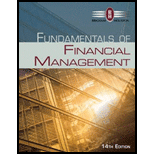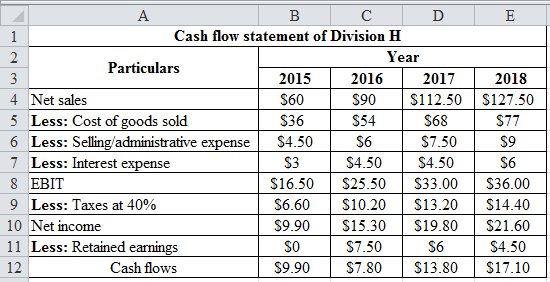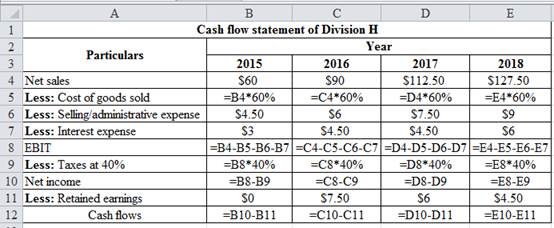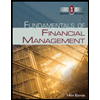
a.
To Determine: The reasons that is economically justifiable among tax considerations, control, synergy, risk reduction and buying of assets at below-replacement cost.
Introduction: A merger is the mix of two organizations into one by either shutting the old entities into one new entity or by one organization engrossing the other. In other terms, at least two organizations are united into one organization to form a merger.
a.
Explanation of Solution
The reasons that are economically justifiable among tax considerations, control, synergy, risk reduction and purchase of assets at below-replacement cost is as follows:
The rationale that is economically justifiable for mergers are synergy and tax consequences. Synergy happens when the estimation of the joined firm surpasses the total of the estimations of the organizations taken independently. A synergistic merger makes value that must be allotted between the stockholders of the merging organizations.
Synergy can emerge from the below four sources:
- Through expanded market control because of decreased rivalry. The operating and money related economies are socially appropriate, as mergers that increase the administrative effectiveness, but mergers that decrease rivalry are both unattractive and unlawful.
- Through financial economies, this might incorporate higher debt limit, decreasing transaction expenses, or better inclusion by securities’ examiners that can prompt greater demand and thus greater costs.
- Through operating economies of scale in administration, creation, marketing or conveyance.
- Through differential management effectiveness, which suggests that new administration can expand the value of a firm's assets.
Another legitimate justification behind mergers is tax consideration. For instance, a firm that is extremely cost-effective and thusly in the most noteworthy corporate-tax section could procure an organization with huge accumulated tax losses, and promptly utilize those losses to protect its present and future revenue. Without the merger, the carry forwards may inevitably be utilized, yet their value will be greater whenever utilized now as opposed to the future.
The thought processes that are usually less sustainable on economic positions are risk reduction, buy of assets at lower replacement cost, regulator, and globalization. Managers regularly express that expansion balances out an organization's profit stream and in this manner lessens total risk, and henceforth benefits investors. Equilibrium of profit is absolutely helpful to an organization's workers, providers, clients, and directors. But, if a stock investor is worried about earnings changeability, the concerned investor can diversify more effectively than the firm can.
Occasionally a firm will be publicized as a conceivable procurement contender on the grounds that the replacement value of its assets is extensively higher than it’s fairly market value. Currently, numerous hostile takeovers have happened. In order to preserve their organizations self-regulating and furthermore to secure their occupations, earlier build cautious or defensive mergers which make their organizations harder to "process." Moreover, those defensive mergers are typically debt financed, which makes it tougher for a potential purchaser to utilize debt financing to fund the purchaser. When all is said in done, defensive mergers seem, by all accounts, to be planned more to serve managers than for investors.
An expanded want to end up globalized has brought about numerous mergers. To merge just to end up worldwide is not a financially supported explanation behind a merger; in any case, expanded globalization has prompted expanded economies of scale. Along these lines, synergism regularly results or in other words legitimate purpose behind mergers. Synergy seems, by all accounts, to be the explanation behind this merger.
b.
To Determine: The similarities between hostile merger and friendly merger.
b.
Explanation of Solution
The similarities between hostile merger and friendly merger are as follows:
In a friendly merger, the administration of one firm or also called as the acquirer consents to purchase another firm. In several cases, the activity is started by the acquiring firm, but in a few circumstances the target may start the merger. The administrations of the two firms get together and exercise terms that they accept to be gainful to the two sets of investors. At that point they issue declarations to their investors prescribing that they consent to the merger. Obviously, the shareholders of the target firm ordinarily should vote on the merger, yet administration's help for the most part guarantees that the votes will be advantageous.
If a target company's administration opposes the merger, at that point the purchasing firm's advances are said to be hostile as opposed to friendly. For this situation, the acquirer decides to make an immediate interest to the target firm's shareholders. This appears as a tender offer, whereby the target firm's investors are requested to "tender" their shares to the purchasing firm in return for money, stock, securities, or a mix of the three. In the event that at least 51% of the target firm's shareholders tender their shares, at that point the merger will be finished over administration's opposition.
c.
To Determine: The cash flow statement of Division HH’s from 2015 to 2018, the reasons on why the interest expense deducted in merger cash flow statement and the reasons on why earnings retentions deducted in cash flow statement.
c.
Explanation of Solution
Determine the cash flow statement of Division HH’s from 2015 to 2018
Using a excel spreadsheet, the cash flow statement of Division HH’s from 2015 to 2018 is determined.
Excel Spreadsheet:

Excel Workings:

The reasons on why the interest expense deducted in merger cash flow statement is as follows:
It is necessary to note that these declarations are indistinguishable to ordinary capital budgeting cash flow statements with the exception of that both interest expense and maintenances are incorporated into merger examination. In straight capital budgeting, all debt included is new debt that is issued to finance the asset accompaniments. Consequently, the debt included all costs the equivalent, the rate of debt (rd) and this expense is represented by reducing or discounting the cash streams at the company's weighted average cost of capital.
But, in a merger the procuring firms normally both expect the current debt of the target and issues new debt to fund the takeover. In this way, the debt included has diverse expenses, and consequently cannot be represented as a solitary expense in the weighted average cost of capital. The most effortless clarification is to unequivocally incorporate interest expense in the cash flow statement.
The reasons on why earnings retentions deducted in cash flow statement is as follows:
Concerning to the retentions, the majority of the cash streams from an individual project are accessible for use all through the firm, however a portion of the cash streams produced by a procuring are for the most part held with the new partition to assist its growth. Since such retentions are not accessible to the parent organization for utilize somewhere else, they should be removed in the cash flow statement. With interest expense and retentions incorporated into the cash flow statements, the cash streams are residuals that are accessible to the obtaining company's equity holders. Company SHR’s administration could pay these out as dividends or reinvest them in different partitions of the firm.
d.
To Determine: The appropriate discount rate to apply to the cash flows developed in the previous part and the actual estimate of the discount rate.
d.
Answer to Problem 8IC
The actual estimate of the discount rate is 14.2%.
Explanation of Solution
The appropriate discount rate to apply to the cash flows developed in the previous part is as follows:
From the above discussions, the cash streams are residuals, and they have a place with the obtaining company's shareholders. Since interest expense has just been measured, the cash streams are more risky than the characteristic capital budgeting cash streams, and they should be discounted utilizing the
Though, the market risk of the Division HH is not the equivalent as the market risk of Company HH working freely, in light of the fact that the merger influences Company HH’s leverage and tax rate. Company SHR’s investment bankers have assessed the Division HH’s beta will be 1.3 after the merger and the extra leverage has been utilized.
Determine the actual estimate of the discount rate
Here,
rF - Risk free rate
rM - Market risk premium
B - Beta of stock
Therefore the actual estimate of the discount rate is 14.20%.
e.
To Determine: The estimated continuing value of acquisition and the value of Company HH to Company SHR and whether it would be the same value if another firm evaluating Company HH as acquisition.
e.
Answer to Problem 8IC
The estimated continuing value of acquisition is $221.05 million and the value of Company HH to Company SHR is $163.93 million.
Explanation of Solution
Determine the estimated continuing value of acquisition
Here,
g – Growth rate
rs – Discount rate
Therefore the estimated continuing value of acquisition is $221.05 million.
Determine the value of Company HH to Company SHR
Using a excel spreadsheet, the value of Company HH to Company SHR is determined as $163.93 million.
Excel Spreadsheet:

Excel Workings:

Therefore the value of Company HH to Company SHR is $163.93 million.
The reasons on whether it would be the same value if another firm evaluating Company HH as acquisition is as follows:
In the event that another firm was valuing Company HH, they would most likely acquire an estimate not quite the same as $163.93 million. Most imperative, the synergies included would probably be dissimilar, and henceforth the cash flow estimates would contrast. Likewise, another potential acquirer may utilize diverse financing methods, or have an alternate tax rate, and consequently determine an alternate discount rate.
f.
To Determine: Whether Company SHR makes an offer for Company H, if offered the share price.
f.
Explanation of Solution
Determine the current market value of Company HH
Therefore the current market value of Company HH is $90 million.
Determine the difference of value
Since Company HH's expected value to Company SHR’s is $163.9 million, it creates the impression that the merger would be valuable to the two sets of investors.
Therefore the difference of value is $73.93 million.
Determine the range of share price
The price of the share several weeks ago was $9.
Therefore the range of share price is between $9 and $16.393
The reasons on whether Company SHR makes an offer for Company H is as follows:
At a share price of $9, the majority of the advantage of the merger goes to Company SHR’s investors, while with a share price of $16.39, the majority of the value made goes to Company HH's investors. If Company SHR’s offers more than $16.39 per share, at that point the wealth would be exchanged from Company SHR’s investors to Company HH's investors. With regards to the real offering value, Company SHR’s should make the offer as low as could reasonably be expected, yet adequate to Company HH's investors. A low starting offer, roughly $9.50 per share, would likely be rejected and the exertion squandered.
Additionally, the offer may impact other potential suitors to think about Company HH, and they could emerge outbidding Company SHR’s. On the other hand, a high value, roughly $16, passes the majority of the gain to Company HH's investors, and Company SHR’s administrators ought to hold however much of the synergistic value as could be expected for their very own investors. It is also necessary to note that this argument expect that Company HH's price of $9 as "reasonable," equilibrium value without a merger. As the stock trades irregularly, the share price of $9 may not signify to a reasonable least cost. Company HH's administration should make an assessment of a reasonable cost and utilize this data in its transactions with Company SHR.
g.
To Determine: The merger related activities that are undertaken by investment bankers.
g.
Explanation of Solution
The merger related activities that are undertaken by investment bankers are as follows:
- Risk arbitrage conjecturing in the stocks of organizations that are expected to takeover targets
- Assisting target organizations in creating and applying cautious strategies
- Assisting to value target organizations
- Assisting to organize mergers
- Assisting in financing mergers
Want to see more full solutions like this?
Chapter 21 Solutions
Fundamentals of Financial Management (MindTap Course List)
- Smitty’s Home Repair Company, a regional hardware chain that specializes in do-it-yourself materials and equipment rentals, is cash rich because of several consecutive good years. One of the alternative uses for the excess funds is an acquisition. Linda Wade, Smitty’s treasurer and your boss, has been asked to place a value on a potential target, Hill’s Hardware, a small chain that operates in an adjacent state, and she has enlisted your help. Table below indicates Wade’s estimates of Hill’s earnings potential if it comes under Smitty’s management (in millions of dollars). The interest expense listed here includes the interest (1) on Hill’s existing debt, (2) on new debt that Smitty’s would issue to help finance the acquisition, and (3) on new debt expected to be issued over time to help finance expansion within the new “H division,” the code name given to the target firm. The retentions represent earnings that will be reinvested within the H division to help finance its growth.…arrow_forwardCash acquisition decision Benson Oil is being considered for acquisition by Dodd Oil. The combination, Dodd believes, would increase its cash inflows by $25,000 for each of the next 5 years and by $50,000 for each of the following 5 years. Benson has high financial leverage, and Dodd can expect its cost of capital to increase from 12% to 15% if the merger is undertaken. The cash price of Benson is $125,000. Would you recommend the merger? Would you recommend the merger if Dodd could use the $125,000 to purchase equipment that will return cash inflows of $40,000 per year for each of the next 10 years? If the cost of capital did not change with the merger, would your decision in part b be different? Explain.arrow_forwardBirdie Golf, Inc., has been in merger talks with Hybrid Golf Company for the past six months. After several rounds of negotiations, the offer under discussion is a cash offer of $352 million for Hybrid Golf. Both companies have niche markets in the golf club industry, and the companies believe a merger will result in significant synergies due to economies of scale in manufacturing and marketing, as well as significant savings in general and administrative expenses. Bryce Bichon, the financial officer for Birdie, has been instrumental in the merger negotiations. Bryce has prepared the following pro forma financial statements for Hybrid Golf assuming the merger takes place. The financial statements include all synergistic benefits from the merger: 2019 2020 2021 2022 2023 Sales $409,600,000 $460,800,000 $512,000,000 $576,000,000 $640,000,000 Production costs 287,400,000 332,500,000 358,400,000 404,500,000 451,200,000 Depreciation…arrow_forward
- Birdie Golf, Inc., has been in merger talks with Hybrid Golf Company for the past six months. After several rounds of negotiations, the offer under discussion is a cash offer of $352 million for Hybrid Golf. Both companies have niche markets in the golf club industry, and the companies believe a merger will result in significant synergies due to economies of scale in manufacturing and marketing, as well as significant savings in general and administrative expenses. Bryce Bichon, the financial officer for Birdie, has been instrumental in the merger negotiations. Bryce has prepared the following pro forma financial statements for Hybrid Golf assuming the merger takes place. The financial statements include all synergistic benefits from the merger: 2019 2020 2021 2022 2023 Sales $409,600,000 $460,800,000 $512,000,000 $576,000,000 $640,000,000 Production costs 287,400,000 332,500,000 358,400,000 404,500,000 451,200,000 Depreciation…arrow_forwardBirdie Golf, Inc., has been in merger talks with Hybrid Golf Company for the past six months. After several rounds of negotiations, the offer under discussion is a cash offer of $352 million for Hybrid Golf. Both companies have niche markets in the golf club industry, and the companies believe a merger will result in significant synergies due to economies of scale in manufacturing and marketing, as well as significant savings in general and administrative expenses. Bryce Bichon, the financial officer for Birdie, has been instrumental in the merger negotiations. Bryce has prepared the following pro forma financial statements for Hybrid Golf assuming the merger takes place. The financial statements include all synergistic benefits from the merger: 2019 2020 2021 2022 2023 Sales $409,600,000 $460,800,000 $512,000,000 $576,000,000 $640,000,000 Production costs 287,400,000 332,500,000 358,400,000 404,500,000 451,200,000 Depreciation…arrow_forwardBirdie Golf, Inc., has been in merger talks with Hybrid Golf Company for the past six months. After several rounds of negotiations, the offer under discussion is a cash offer of $352 million for Hybrid Golf. Both companies have niche markets in the golf club industry, and the companies believe a merger will result in significant synergies due to economies of scale in manufacturing and marketing, as well as significant savings in general and administrative expenses. Bryce Bichon, the financial officer for Birdie, has been instrumental in the merger negotiations. Bryce has prepared the following pro forma financial statements for Hybrid Golf assuming the merger takes place. The financial statements include all synergistic benefits from the merger: 2019 2020 2021 2022 2023 Sales $409,600,000 $460,800,000 $512,000,000 $576,000,000 $640,000,000 Production costs 287,400,000 332,500,000 358,400,000 404,500,000 451,200,000 Depreciation…arrow_forward
- XYZ Auto, a national autoparts chain, is considering purchasing a smaller chain, ABC Auto. Pit Row’s analysts project that the merger will result in incremental net cash flows of $2 million in Year 1, $4 million in Year 2, $5 million in Year 3, and $117 million in Year 4. The Year 4 cash flow includes a terminal value of $107 million. Assume all cash flows occur at the end of the year. The acquisition would be made immediately, if it is undertaken. ABC’s post-merger beta is estimated to be 2.0, and its post-merger tax rate would be 34 percent. The risk-free rate is 8 percent, and the market risk premium is 4 percent. What is the value of ABC Auto to XYZ Auto?arrow_forwardCharging Corporation and Sparking Electrical Company are competitors in the business of electrical components distribution. Sparking is the smaller firm and has attracted the attention of the management of Charging, for Sparking has taken away market share from the larger firm by increasing its sales force over the past few years. Charging is considering a takeover offer for Sparking and asked you to serve on the acquisition valuation team that will turn into due diligence team if an offer is made and accepted. Given the financial information and proposal assumptions that follows, how would you respond to (a) and (b)? Sparking Electrical Company Condensed Income Statement Previous five years (in $ million) 2009 2008 2007 2006 2005 Revenues 1,626.50 1614.10 1485.20 1380.50 1373.40 – Cost of goods sold 1,488.10 1490.90 1359.50 1271.40 1268.00 Gross profits 138.40…arrow_forwardMelissa’s Kitchen is considering acquiring Takeshi’s Takeout Corp., a small local restaurant chain. Expected net cash flows from the acquisition for the first four years of the post-merger period are: Year 1 $350,000 Year 2 $400,000 Year 3 $475,000 Year 4 $550,000 After four years, the net cash flows are expected to grow at a constant rate of 3 percent per year. If we know the following information, what is the most Melissa’s Kitchen Should pay for Takeshi’s Takeout? Melissa’s Kitchen Borrowing costs 5% above the current long-term Treasury Bond rate 10-year T-Bond Rate 2/8/23 = 3.64% Beta 2.4 Debt $4 million Stock 500,000 shares outstanding - $20 per share on 2/8/23 Tax Rate 21 percentarrow_forward
- The Manager of Posh & Nails that is based in Sta Monica, Puerto Princesa is seeking to grow their business. Posh & Hairs that is based in Sicsican is the Posh & Nails number one competitor. Due to pandemic, and after a long day of due diligence and negotiation they agree that if they combine their businesses they'll enjoy significant synergies. How would you best describe the combination of the businesses A. Merger B. Acquisition C. Merger & Acquisitionarrow_forwardPizza Place, a national pizza chain is considering purchasing a smaller chain, Western Mountain Pizza. Projected cash flows as a result of the merger are: Year1, $1,500,000; Year2, $2,000,000; Year3, $3,000,000; Year4, $5,000,000. In addition, Western's year4 cashflows are expected to grow at a constant rate of 5% after year 4. Western's post-merger beta is estimated to be 1.5 and its post-merger tax rate is 40%. The risk-free rate is 6% and the market risk premium is 4%. REQUIRED: 1. What is the maximum bid price per share of Pizza Place for Western Mountain Pizza? 2. If Western Mountain Pizza has 5,000,000 outstanding shares and are currently selling at $13. How much is the minimum acceptable price (in total) for Western Mountain Pizza?arrow_forwardVelcro Saddles is contemplating the acquisition of Skiers’ Airbags Inc. The values of the two companies as separate entities are $20 million and $10 million, respectively. Velcro Saddles estimates that by combining the two companies, it will reduce marketing and administrative costs by $500,000 per year in perpetuity. Velcro Saddles is willing to pay $14 million cash for Skiers’. The opportunity cost of capital is 8%. a. What is the gain from the merger? b. What is the cost of the cash offer? c. What is the NPV of the acquisition under the cash offer? Please answer fast i give you upvote.arrow_forward
 Intermediate Financial Management (MindTap Course...FinanceISBN:9781337395083Author:Eugene F. Brigham, Phillip R. DavesPublisher:Cengage Learning
Intermediate Financial Management (MindTap Course...FinanceISBN:9781337395083Author:Eugene F. Brigham, Phillip R. DavesPublisher:Cengage Learning Fundamentals of Financial Management (MindTap Cou...FinanceISBN:9781285867977Author:Eugene F. Brigham, Joel F. HoustonPublisher:Cengage Learning
Fundamentals of Financial Management (MindTap Cou...FinanceISBN:9781285867977Author:Eugene F. Brigham, Joel F. HoustonPublisher:Cengage Learning Financial Accounting: The Impact on Decision Make...AccountingISBN:9781305654174Author:Gary A. Porter, Curtis L. NortonPublisher:Cengage Learning
Financial Accounting: The Impact on Decision Make...AccountingISBN:9781305654174Author:Gary A. Porter, Curtis L. NortonPublisher:Cengage Learning Fundamentals of Financial Management (MindTap Cou...FinanceISBN:9781337395250Author:Eugene F. Brigham, Joel F. HoustonPublisher:Cengage Learning
Fundamentals of Financial Management (MindTap Cou...FinanceISBN:9781337395250Author:Eugene F. Brigham, Joel F. HoustonPublisher:Cengage Learning





